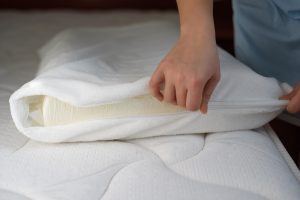Professional pest control experts utilize a combination of training, experience, specialized tools, and sometimes even trained animals to check for bed bugs. Here’s a brief overview of their approach:
- Visual Inspection: Professionals begin with a meticulous visual inspection, similar to the one described earlier, but with more practiced eyes. They check all the typical hiding places, including beds, furniture, and even less obvious spots.
- Use of Tools: A professional might use tools like magnifying glasses, probes, and flashlights to inspect tight crevices, seams, and folds in furniture and bedding. Some might even use sticky traps in strategic areas to capture wandering bed bugs.
- Bed Bug Detection Dogs: Some professionals use specially trained dogs to sniff out bed bug infestations. These dogs are trained to detect the scent of live bed bugs and their eggs. Their acute sense of smell allows for rapid and accurate detection, especially in large areas.
- Monitoring Devices: These are devices placed in potential bed bug hotspots, designed to trap or lure in and capture bed bugs. They can be passive (relying on bed bugs’ natural behavior) or active (using heat or CO2 to attract bed bugs).
- Use of Heat: Some professionals use portable heaters and sensors to raise room temperatures, drawing bed bugs out of hiding spots. This method is more commonly used for eradication, but it can also reveal infestation areas.
- Professional Experience: Experienced pest control experts are trained to identify the signs of bed bugs, such as fecal spots, eggs, and shed skins. They can often spot signs of an infestation that might be overlooked by the untrained eye.
- Consultation: After the inspection, professionals will discuss their findings, recommend a course of action if bed bugs are present, and provide advice on prevention.
While DIY inspections can be effective, professionals offer a more comprehensive and accurate assessment, especially in cases of minor or challenging-to-detect infestations. If you suspect a bed bug problem, it’s often wise to get a professional opinion to ensure you’re addressing the issue thoroughly.




